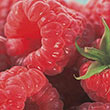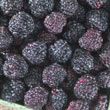Shop Categories
- New This Season
- Only From Gurney's
- Vegetables
- Fruits
- Perennials, Bulbs & Flowers
- Trees & Shrubs
- Customer Favorites
- Gardens Alive! & Supplies
- Gurney's Choice
- Niles' Favorites
- Deer Resistant Plants
- Sale

Raspberry Plants
Choosing the Right Raspberry Bush
When looking at the raspberry bushes for sale, how do you know the best varieties for you? Start by selecting ones that perform in your grow zone. Some raspberry bushes are very cold hardy and grow well in the North, while other raspberries thrive in the Southern zones. Next consider if you want to grow black, red or golden raspberries. Other considerations are when the raspberries ripen, if they're double cropping (producing fruit twice a year) and if you'd like to try a thornless raspberry bush.Raspberry Plants: Getting the Most out of Your Purchase
To get the best performance out of your raspberry bushes, plant them in full sun and in loamy, well-drained soil. Whether you've planted a black, golden, or red raspberry plant you should provide them with a trellis, fertilize them and avoid overcrowding them.Raspberry bushes are easy to grow, if you take care with site selection, planting and some basic maintenance. Because they are heavy feeders, we also recommend feeding them with the specially formulated Gurney's Blackberry and Raspberry Food.
Where to Plant Raspberries
Site selection is very important when planting raspberries. Raspberry trees prefer and are most productive when planted in full sun (direct sunlight) and loamy, well-drained soil. They also need space. Usually, yellow and red raspberry plant varieties are planted 2 ft. apart and the purple and black raspberry tree varieties are planted 3 ft. apart. To prevent the spread of disease, plant purple and black varieties at least 300 ft. from red and golden varieties. All raspberry bushes benefit from a trellis.When to Plant Raspberries
Raspberry bushes can be planted in the spring or the fall. Planting in the fall allows the plants to put all of their energy into establishing their roots rather than growing foliage.How to Plant Raspberries
Your raspberry plant may arrive as a bareroot plant or a potted fruit plant. If it's bareroot, soak it in water for about 15 minutes before planting. Dig a hole that allows the roots to spread. Many people dig a hole that is about twice the size of the container. After planting, water regularly (about once a week during the growing season).When to Prune Raspberries
Little, if any pruning, is needed during the first few years. After that, annual pruning will keep your raspberry plants productive, healthy and looking good. Pruning is often done after harvest and in early spring.How to Prune Raspberries
Remove the fruiting canes after raspberry harvest. Black and purple raspberry plants can be pruned in the spring, leaving 10-15 buds per cane and four-five canes per clump. Encourage branching by pinching back the tips of black raspberry plants in late summer. With red and yellow raspberries, remove suckers rather than canes from original plants.Understanding Your Raspberry Plant Varieties
When selecting raspberry plants, you have many choices. Choose from red, yellow or black raspberry varieties. Plants may be summer bearing, fall bearing or double cropping. A few varieties have thornless canes for easy picking. Here are some varieties to consider:
Anne: Produces large, sweet, yellow berries that ripen in late summer to fall.Caroline: Considered the best-tasting red raspberry with fruits that ripen in the fall. A good Southern performer.
Canby: Thornless red variety is also very cold hardy. A good Northern performer.
Red Latham: Cold hardy and disease-resistant red is a reliable favorite for producing premium quality berries in the summer. Very adaptable to a range of soil types.
Heritage: Thrives most anywhere and bears red, juicy fruits in midsummer and again in late summer to fall. Exhibits good disease resistance.
Jewel: Consistent producer of purple-black berries in early July. Vigorous plants resist anthracnose disease.
Jaclyn: Southern tough variety resists insects and disease and produces super sweet red fruits twice a year. Canes are cold-tolerant.
Sweet Repeat Red: Bears a crop of large, dark red, sweet berries in June and a second in the fall. Good producer in warmer climates.
Sweet Repeat Black: First crop of juicy, black berries ripen in early June before most other varieties. Bears a second crop in late summer.
Fall Gold: Everbearing variety produces golden, sweet berries from midsummer to early fall. Adaptable to many soil types.
Born Free: Thornless plants produce bountiful crops of deep purple berries in the summer. Plants exhibit no significant pests or disease problems.
Crimson Night: Double-cropping variety with dark red-purple fruits that were taste-test winners. More compact habit makes it suitable for containers.
Tips for Harvesting Raspberries
- Harvest berries when the plants are dry.
- Raspberries are ripe and ready for harvest when the fruits are tender, not hard. They should come easily off the plant. If you have to tug on them, they probably are not ripe.
- Most raspberry varieties ripen over a few weeks, and should be harvested every few days.
- When picking and storing raspberries, place them in shallow containers.
- Raspberries only keep well for a few days after harvest. For the best berries, eat fresh or store in the refrigerator for a few days. Wait to wash until ready to use.
Raspberry Plant Pests & Diseases
Raspberry plants can suffer from fungal, bacterial and viral diseases. Common raspberry diseases include gray mold, cane blight, anthracnose and raspberry leaf spot. Preventative disease control measures include avoiding handling plants when they are wet, sanitizing pruning equipment, and buying disease-free nursery stock.
Common raspberry insect pests include Japanese beetles, cane borers and aphids. Monitor the plants for signs of insect pest damage.





 Gardens Alive! & Supplies
Gardens Alive! & Supplies



 Southern Grove Raspberries
Southern Grove Raspberries
 Black Raspberries
Black Raspberries
 Golden Raspberries
Golden Raspberries


